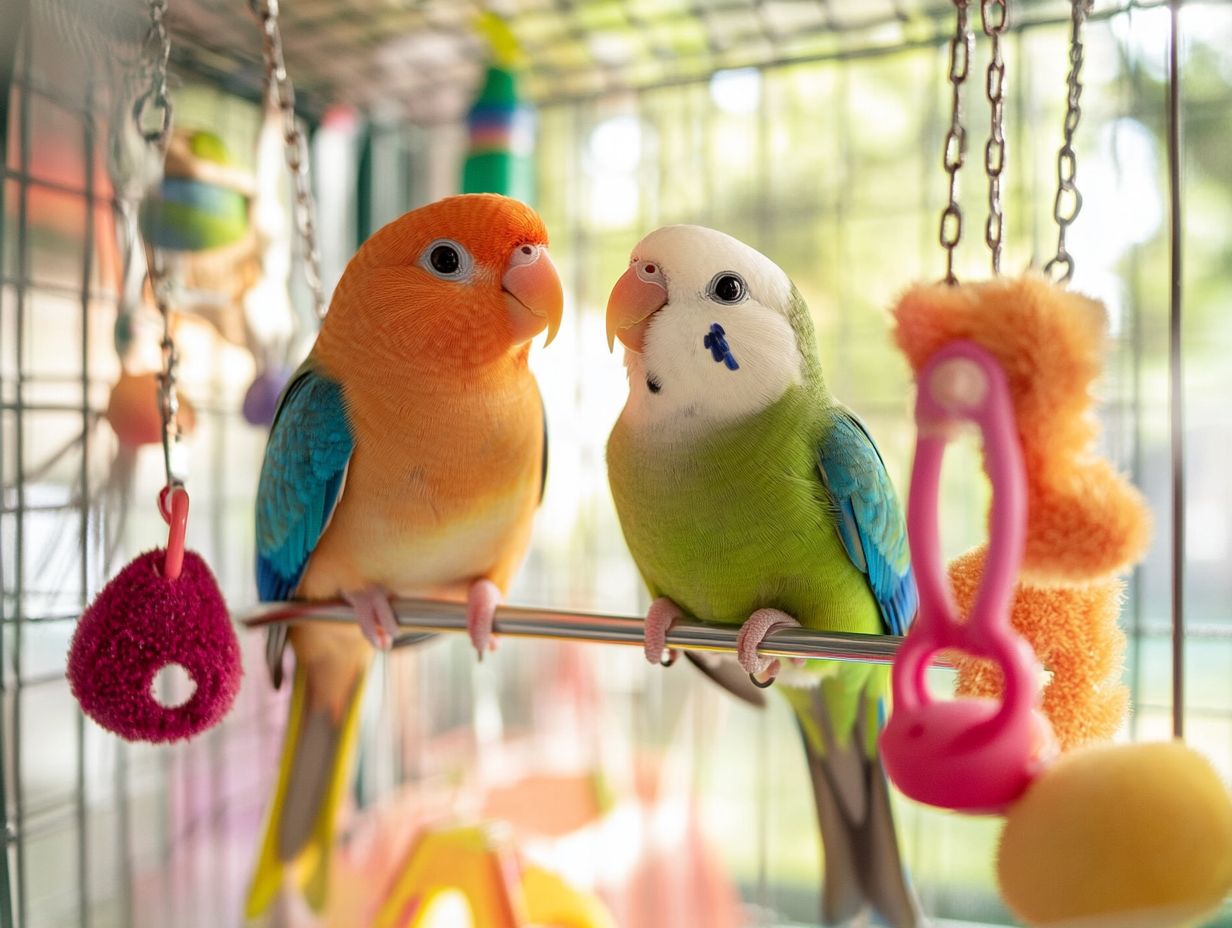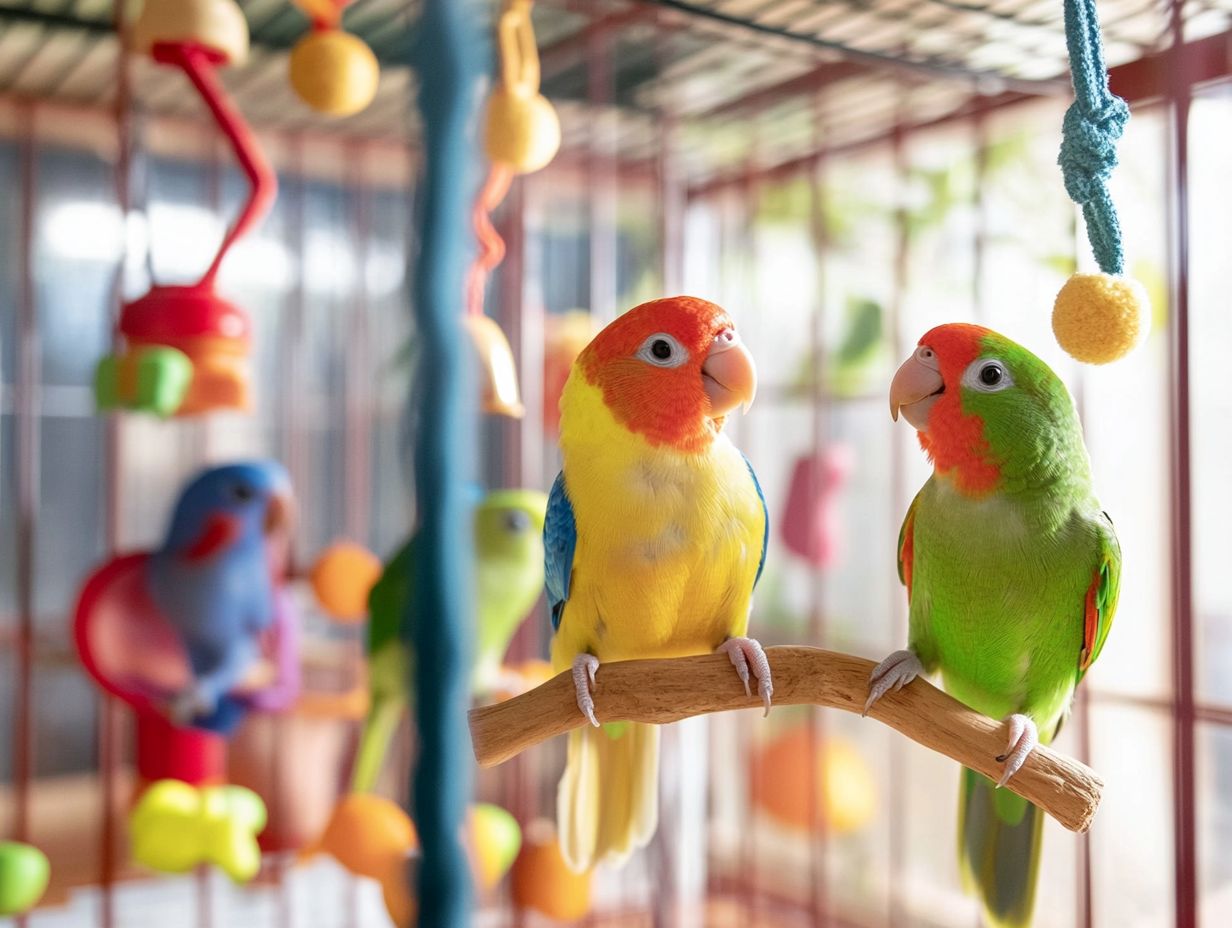How to Safely Use Bird Toys with Multiple Birds
Creating a stimulating and safe environment for your birds is essential for their well-being, particularly when you have multiple birds in your care.
This article delves into the significance of bird toys. It spotlights interactive and chewing options that will keep your feathered friends engaged and content.
You ll also find important safety tips, such as size and material considerations, alongside best practices for supervision and rotating toys.
Explore easy DIY bird toy ideas that can elevate their playtime experience. Don t wait! Your birds deserve the best, so let s dive in now!
Contents
Key Takeaways:

- Consider the size and material of bird toys when buying for multiple birds to ensure safety and prevent choking hazards.
- Rotate and supervise playtime with bird toys to prevent fighting and maintain their interest in the toys.
- DIY bird toys can be a safe and affordable option for multiple birds, such as using paper rolls or untreated wood pieces for chewing toys.
Why are Bird Toys Important?
Bird toys are essential for promoting the health and welfare of your birds. They cater to their natural behaviors, providing both engagement and physical activity.
Just like you, birds thrive when they have mental and physical engagement. Thus, selecting safe toys is crucial for their overall well-being.
Choosing the right toys not only prevents boredom but also encourages healthy behaviors. This helps reduce stress and anxiety in your feathered friends.
Engaging with suitable toys can significantly enhance your bird’s quality of life. It ensures regular exercise and keeps their minds active.
This engagement is vital for staving off behavioral issues like feather plucking or excessive screeching, which often arise from a lack of stimulation.
Prioritizing toy safety is paramount. Always opt for materials that are non-toxic and free from harmful chemicals. Ensure that the design has no small parts that could pose choking hazards.
Choosing the right toys shows just how much you care about your bird’s happiness and health!
Considerations for Multiple Birds
When selecting toys for your flock, it s vital to consider each bird’s unique personality and preferences. This way, you can choose toys that encourage interaction while keeping conflicts at bay.
Take the time to observe how they interact during playtime. This can reveal invaluable insights into their interests and preferences, making it much easier for you to select the right items.
Don’t forget to tap into community feedback from fellow bird owners for practical advice on toys that foster cooperation rather than competition.
Utilizing online resources can further enhance your understanding of bird behaviors and needs. Regularly monitoring droppings is essential for their health, as any changes can signal underlying issues.
Keeping an eye on each bird’s activity level and appetite will also aid in assessing their well-being. This ensures that every feathered companion thrives in a harmonious environment.
Types of Bird Toys
Bird toys can be elegantly categorized into various types, each designed to fulfill a specific role in fostering both physical activity and mental stimulation for your birds.
From interactive toys that promote social engagement and cognitive challenges to chewing toys that help maintain healthy beaks, grasping the nuances of these different types is essential for elevating your birds’ quality of life.
When selecting toys, prioritize those crafted from safe, durable, and non-toxic materials. This ensures that your feathered friends can confidently explore and relish their surroundings without any health concerns.
Interactive Toys

Interactive toys engage your birds mentally and physically. They challenge their instincts and encourage healthy behaviors.
These toys often feature puzzles, ways for birds to find food, and social interactions key elements for bird enrichment and cognitive stimulation.
You ll discover a variety of interactive toys tailored to different species and personalities. Options range from simple hanging bells and mirrors to intricate maze-like structures that require clever problem-solving skills.
Engaging with these toys keeps your birds entertained and offers a unique opportunity to observe their behavior. This provides valuable insights into their health and well-being.
For example, an increase in playtime typically indicates a happy, healthy bird. Conversely, a lack of interest might hint at underlying issues. Investing in these toys elevates their mental and social engagement while also helping you monitor your feathered friends overall health.
Chewing Toys
Chewing toys are essential for maintaining your parrot’s beak health and encouraging natural behaviors. They satisfy your bird’s instinct to gnaw and chew, promoting overall welfare.
These toys also help reduce boredom. A mentally stimulated bird is much less likely to develop unwanted habits like feather plucking or aggression.
Various materials are commonly used in crafting these toys, including wood, grass, and safe plastics. Always choose non-toxic options to ensure the safety and health of your feathered companion.
Offering a variety of chewing toys makes playtime exciting and fun for your bird! Different textures and materials enrich their environment and encourage physical activity.
Safety Tips for Multiple Birds at Play
Ensuring the safety of bird toys in a multi-bird household requires understanding potential hazards. For more information, consider selecting safe chew toys for your bird and implement effective strategies for supervision and toy rotation.
Prioritize your pets’ safety by conducting regular inspections of their toys. This significantly minimizes risks, fostering a healthier living environment for your cherished feathered companions.
Size and Material Considerations
When selecting bird toys, consider size and material to keep your feathered friends safe and entertained. For more insights, refer to understanding bird behavior with toys. The toys should be appropriately sized to prevent choking hazards.
Choosing the right size provides physical stimulation and helps prevent injury; larger toys can pose risks for smaller birds. Opt for materials like natural wood, untreated rawhide, and safe acrylic they’re tough enough to withstand beaks while remaining gentle on your birds’ sensitive feet.
Regularly inspect the toys for wear and tear. Ensure they lack sharp edges or small parts that could be swallowed. Understanding the dangers of bird toys is essential, as prioritizing quality and safety in your birds’ playthings creates a healthy environment that encourages their natural curiosity and activity.
Choose the right toys today and watch your feathered friends thrive!
Supervision and Rotation

Supervision and rotation of bird toys are essential practices for maintaining pet safety and promoting overall bird welfare, especially in a multi-bird environment. Monitor your birds during playtime, and consider how to use toys in bird training to enhance their engagement. Rotate their toys regularly to prevent boredom, reduce anxiety, and ensure equal play opportunities.
These practices also foster mental stimulation, which is crucial for their psychological well-being. When your birds engage in play, they express their natural behaviors and enjoy physical activity, keeping them healthy and happy.
To effectively implement toy rotation, establish a schedule. Introduce new toys weekly while removing others to maintain their interest. Opt for toys made from safe, non-toxic materials to enhance their safety.
Observe how each bird interacts with various toys. Tailor your ways to keep them engaged to cater to each bird’s unique personality and preferences.
DIY Bird Toys for Multiple Birds
Crafting DIY bird toys is a fulfilling and budget-friendly approach to offering your avian companions safe and engaging playthings. Get creative! You can customize toys to perfectly suit your birds needs.
By selecting safe and durable materials, you foster cognitive stimulation and encourage interactive play. This ensures your feathered friends stay mentally and physically active.
Easy and Safe Options
For bird owners like yourself, seeking easy and safe options for DIY bird toys opens up a world of creativity and play. Utilize safe materials think untreated wood, natural fibers, and non-toxic dyes to craft toys that foster interaction and enrich your bird s environment.
Consider a colorful hanging toy made from strips of untreated wood. Drill and thread them together with natural jute rope for a delightful creation. Another fantastic idea is to wrap pieces of cardboard with hemp twine to create a chewable toy, satisfying your bird s instinct to chew while providing mental stimulation.
Don’t overlook simple yet effective paper towel rolls filled with shredded paper. These can encourage foraging behavior and keep your feathered friend entertained. Each of these projects promotes physical activity and engages your bird’s mind, reinforcing the special bond between you and your pet.
Frequently Asked Questions
Can I use the same bird toys for all of my birds?

No, it is not recommended to use the same toys for all of your birds. Each bird has its own unique play style and may become possessive over their toys. To keep things organized and encourage healthy play, consider learning how to store bird toys and accessories. It is important to provide each bird with its own set of toys to prevent potential conflicts.
What size toys are right for my birds?
The size of the toys should be appropriate for your birds. Ensure the toys are not too small, as they can pose a choking hazard, and not too large, as it may be difficult for your birds to manipulate and play with them. Consult with a bird expert or research recommended toy sizes for your specific bird species.
Can I leave bird toys unsupervised with my birds?
No, it is not recommended to leave bird toys unsupervised with your birds. Birds are curious and can potentially get stuck in or swallow small pieces of the toys. It is important to monitor your birds while they play with their toys and remove any damaged or potentially harmful pieces.
How often should I rotate my birds’ toys?
Rotate your birds’ toys every 1-2 weeks. This prevents boredom and allows for regular cleaning and inspection of the toys for any potential hazards.
What materials should I avoid in bird toys?
Avoid toys made from toxic materials such as zinc, lead, and plastic that can easily be chewed or swallowed. Always opt for bird-safe materials such as untreated wood, natural fibers, and food-grade dyes.
Start crafting today for happy and healthy birds!
Can I Make My Own Bird Toys?
Absolutely! You can create fantastic bird toys yourself. Just ensure you choose bird-safe materials and stick to the recommended sizes for your feathered friends.
Don t forget to check your toys regularly. Replacing any damaged pieces keeps your bird safe and happy!






